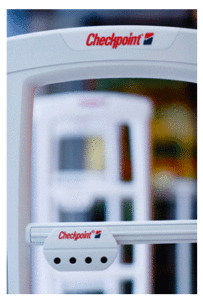 We supply and install the best anti-shoplifting equipment made. Checkpoint Systems is the gold standard of Electronic Article Surveillance (EAS) equipment. Support is off the chart. Checkpoint Systems has factory Tech’s everywhere, I mean EVERYWHERE. They have to since the majority of the top retailers in the world are using Checkpoint equipment. These Techs are not sub-contractors. They are skilled EAS, Radio Frequency (RF) experts. As an example, my Sr. Tech Dan is a former Navy Electronics Technician; he worked on highly advanced systems that protect our country.
We supply and install the best anti-shoplifting equipment made. Checkpoint Systems is the gold standard of Electronic Article Surveillance (EAS) equipment. Support is off the chart. Checkpoint Systems has factory Tech’s everywhere, I mean EVERYWHERE. They have to since the majority of the top retailers in the world are using Checkpoint equipment. These Techs are not sub-contractors. They are skilled EAS, Radio Frequency (RF) experts. As an example, my Sr. Tech Dan is a former Navy Electronics Technician; he worked on highly advanced systems that protect our country.
That’s all good and well but we can install the best equipment using the best people out there but if you do not have the right attitude, you will not have solved your shoplifting problem. You will simply have spent money and felt good about what you purchased but YOUR SHOPLIFTING PROBLEM WILL COME BACK.
You have to instill the right attitude about shoplifting prevention in yourself and your staff. Shoplifters are not afraid of the Checkpoint equipment all by itself. But, they are very afraid of the Checkpoint equipment when it is supported by a trained, knowledgeable staff. The equipment will work. It will notify you when someone tries to steal a protected piece of merchandise. But you have to be on your game long before this happens. Do you know what shoplifters look like? Do you know how to spot them before they steal? You can easily expose a shoplifter in your store with the proper customer service techniques. These skills will not make the shoplifter transparent but will delight your good customers and increase your sales. Good customers love attention, shoplifters hate it.
I believe this so deeply that we at Loss Prevention Systems include free, live shoplifting training as often as you reasonably need it. Staff changes, new manager or supervisor, new employees that are new to retail or your store? Let us train them, free of charge, for the life of your Checkpoint System when you buy it from Loss Prevention Systems.
So you get actual LP training from a former Director of Loss Prevention with over 35 years of experience. FREE!
So if training is the key, why do you still need the Checkpoint System? That is a great question and the answer is simple. The equipment is there to support you when you cannot be everywhere at the same time. Retailers’ biggest expense is labor. If we can keep labor dollars down, we are more profitable. The fact of the matter is that shoplifters seek out and even create situations where they steal when you cannot pay the attention required to spot and deter every shoplifter. By the way, one in ten people that are in your store right now is there to steal from you. That is where the Checkpoint System comes into play. It is working 24/7, does not take breaks, vacations, sick-leave or simply not show up. Checkpoint equipment has a great attitude and is always looking for shoplifters.
Now, what are YOU going to do to change your attitude and start getting the margins from your sales that you deserve? Contact Loss Prevention Systems now and make it happen. Chances are we will actually be able to assist you to begin stopping shoplifters before the system is even delivered and our amazing Techs can install it.
 Loss Prevention Managers and Associates use audits on a regular basis to keep track of merchandise that may be potentially high theft items. The items may be high dollar such as iPods, laptops, computer tablets and so on. The products being audited may simply be easy to steal and resell. Such items can include a variety of products ranging from drill bits to medicines, razor blades and even fragrances. Audits are an effective tool for Loss Prevention departments to quickly identify theft trends and to begin investigating when and how losses are taking place. For stores that cannot afford a Loss Prevention department, it falls upon store owners and managers to investigate missing merchandise. The question then becomes, how does a management team decide what items should be audited or when audits should take place?
Loss Prevention Managers and Associates use audits on a regular basis to keep track of merchandise that may be potentially high theft items. The items may be high dollar such as iPods, laptops, computer tablets and so on. The products being audited may simply be easy to steal and resell. Such items can include a variety of products ranging from drill bits to medicines, razor blades and even fragrances. Audits are an effective tool for Loss Prevention departments to quickly identify theft trends and to begin investigating when and how losses are taking place. For stores that cannot afford a Loss Prevention department, it falls upon store owners and managers to investigate missing merchandise. The question then becomes, how does a management team decide what items should be audited or when audits should take place?  Actions based on good intentions don’t always have good results. One of the most famous of missteps was the Coca-Cola attempt to improve its formula and market “New” Coke. The idea was well-intentioned but the public reception was cool if not outright hostile. According to the website INVESTOPEDIA, “ “Classic Coke” returned to the shelves less than three months after it had been retired.” In the same article, they point out that in 2008 the manufacturer of Motrin found out that there was a problem with the medicine not dissolving properly. Reportedly they did not want to “incur the associated negative publicity, the firm sent out secret shoppers to buy the products off of store shelves, which resulted in a lawsuit in Oregon in 2011.” (“8 Good Intentions With Bad Outcomes”, Lisa Smith, updated December 15, 2017). Laws can have the same problems of unintended consequences, helping one constituency while hurting another.
Actions based on good intentions don’t always have good results. One of the most famous of missteps was the Coca-Cola attempt to improve its formula and market “New” Coke. The idea was well-intentioned but the public reception was cool if not outright hostile. According to the website INVESTOPEDIA, “ “Classic Coke” returned to the shelves less than three months after it had been retired.” In the same article, they point out that in 2008 the manufacturer of Motrin found out that there was a problem with the medicine not dissolving properly. Reportedly they did not want to “incur the associated negative publicity, the firm sent out secret shoppers to buy the products off of store shelves, which resulted in a lawsuit in Oregon in 2011.” (“8 Good Intentions With Bad Outcomes”, Lisa Smith, updated December 15, 2017). Laws can have the same problems of unintended consequences, helping one constituency while hurting another. Reviewing your store policies today and training your employees about the ramification of not following them properly is imperative. The consequences of not following those policies properly are too costly to postpone. Employees, as they are human, try to use shortcuts or in some instances, take the easy way out while doing some chores without thinking it may affect the bottom line at the end of the day. Profits for a store cannot be thought of as profits for the owner only, employment and benefits for the employees are inherently tied to those of the owner. If the owner must close the store for loses, the employees lose as well.
Reviewing your store policies today and training your employees about the ramification of not following them properly is imperative. The consequences of not following those policies properly are too costly to postpone. Employees, as they are human, try to use shortcuts or in some instances, take the easy way out while doing some chores without thinking it may affect the bottom line at the end of the day. Profits for a store cannot be thought of as profits for the owner only, employment and benefits for the employees are inherently tied to those of the owner. If the owner must close the store for loses, the employees lose as well. Inventory in a retail store can offer the management and the loss prevention team a clear picture of whether their efforts are working or they need to modify something entirely different.
Inventory in a retail store can offer the management and the loss prevention team a clear picture of whether their efforts are working or they need to modify something entirely different.  Shoplifters seem to be getting bolder than ever. Much of this is greed. Many people simply want stuff and have no moral compass. Others are emboldened by lax law enforcement or Politicians that pass laws that do little to protect you. Whatever the case be, it has a negative impact on Retailers. We are expected to open our stores, compete, pay employees, pay expenses, taxes…. And make a profit. Shoplifting theft is yet another pressure on us.
Shoplifters seem to be getting bolder than ever. Much of this is greed. Many people simply want stuff and have no moral compass. Others are emboldened by lax law enforcement or Politicians that pass laws that do little to protect you. Whatever the case be, it has a negative impact on Retailers. We are expected to open our stores, compete, pay employees, pay expenses, taxes…. And make a profit. Shoplifting theft is yet another pressure on us. Some people in retail look forward to it and some dread it. What am I talking about? Inventory! From the planning stages and meetings with the inventory counting team to the actual inventory day it can all be a lot to accomplish even for the best of planners. But what happens when you get through the actual counting phase? What comes next? You wait for the results. You may get preliminary results immediately but for larger stores booked inventory may take several weeks and they have teams to analyze the results. As a small retailer you may have to analyze the reports yourself but do you really understand what you are looking for? Are your results accurate? Stores have to keep track of what they have on hand and owners need to know where shortage has taken place and how it has happened.
Some people in retail look forward to it and some dread it. What am I talking about? Inventory! From the planning stages and meetings with the inventory counting team to the actual inventory day it can all be a lot to accomplish even for the best of planners. But what happens when you get through the actual counting phase? What comes next? You wait for the results. You may get preliminary results immediately but for larger stores booked inventory may take several weeks and they have teams to analyze the results. As a small retailer you may have to analyze the reports yourself but do you really understand what you are looking for? Are your results accurate? Stores have to keep track of what they have on hand and owners need to know where shortage has taken place and how it has happened. The IT world has a phrase “garbage in, garbage out”. The same concept applies to hiring new employees. If you do not put effort into selecting a new employee, then chances are you will be disappointed down the road.
The IT world has a phrase “garbage in, garbage out”. The same concept applies to hiring new employees. If you do not put effort into selecting a new employee, then chances are you will be disappointed down the road. March is known for coming in like a lion and going out like a lamb. April showers bring May flowers but what in the world does May bring? May ushers in the summer sales season! Spring is wrapping up and now is the time to be getting your store ready for all of the shoppers looking for the items that will make the long, warm days of June, July and August a memorable time. The big stores are rolling out grills, picnic wares and yard games.
March is known for coming in like a lion and going out like a lamb. April showers bring May flowers but what in the world does May bring? May ushers in the summer sales season! Spring is wrapping up and now is the time to be getting your store ready for all of the shoppers looking for the items that will make the long, warm days of June, July and August a memorable time. The big stores are rolling out grills, picnic wares and yard games.